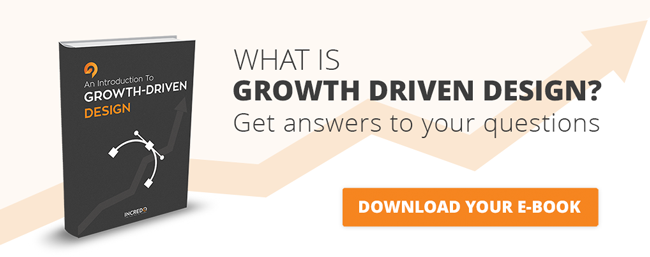When I first got into digital marketing as a career change a few years back (I had previously worked as a financial advisor and had a brief stint starting a study-abroad program for a Chinese government contracted company) I thought the term ‘growth driven design’ was a bit haughty.
It reminded me of an interview I once read with a favorite musician of mine, who was labeled in the music press as an IDM artist, the acronym standing for ‘intelligent dance music’.
The artist’s response, and of course I need to paraphrase here, was: “Intelligent dance music? It makes it sound like other types of dance music aren’t as intelligent as this kind. A bit nasty, innit?” (He was English, and “innit” was the only part I didn’t need to paraphrase, as it’s humorous to read it online when one is a guy born and raised in the US.)
I agreed with his perspective, and felt the same way when ‘growth driven design ’ and ‘GDD’ first began exploding on marketing blogs left and right, bandied about like free candy. Does the term imply that other web design methodologies were somehow not aimed at growing the organization? That these companies NOT using GDD were suckers, and we select few were privy to a pot of marketing gold? Should I feel guilty for knowing how to do this?
Well, yes. I should feel guilty, but only if I refuse to share this knowledge with others. Hence - here we are now.
Before we get into how GDD impacts your sales process, we should clear the air beforehand, and this is not something that every marketing professional will let you know from the get-go…but I will because I’m still a rebel at heart.
Growth driven design is not practical for every organization.
If you are Nike or Coca-Cola, you probably don’t need to be a GDD devotee to the degree that the rest of us do. Until my company attains the market salience and multi-billion revenue of a Bloomberg or Macy’s, I am a convert one hundred percent to the value of GDD.
Also, if you run an organization in certain industries (i.e. legal services, construction work) where your online presence needs to be as consistent and predictable as your personal communications, delivery of services, what-have-you, then GDD might not the best way to approach your web design efforts.
Yet, emphasis on might…
However, if you run a dynamic company, breaking ground with your products or services, trying to edge out the competition as one of the new guys, or any other situation where online customer conversions via your website are vital for your sustainability - welcome, friends. Time to dive in.
So, why doesn’t Mercedes-Benz need GDD?
Once your company has been globally recognized as an industry leader for about 100 years, well, you gained market salience during the entire time that many of your customers were birthed and passed on, all before the internet existed.
Yes, admittedly this is a bit grim, but it’s a fact. Rolex doesn’t need GDD for their web presence. Not to say it can’t be a bit of fun to try it out for those guys, but it could very well plainly be a waste of time and (ahem, negligible degree) of resources.
So, why does your company need GDD?
Because traditional web design approaches are robbing you of potential customers for a crazy number of reasons. I don’t use the word ‘crazy’ as an adjective often, so here’s why it’s warranted:
- You started to grow your company after the dawn of the internet which, for practical purposes, demands that your web presence is your primary line of contact with customers or
- You work in an industry for which a web presence is impossibly valuable for your sales
- The traditional approach of design - a complete overhaul of your website every two years - alienates customers who have not yet had the opportunity to develop brand loyalty to your company
Before I get into the stats (they’re going to happen eventually - this is a blog post about marketing after all), here’s another quick story that illustrates the impact of GDD:
When I was 23 I was department manager at a major domestic chain store outside of NYC. I had retail experience for the preceding five years at four other retail outlets. The one I’m talking about now confused the hell out of me - our merchandisers and designers were spending every single day going over fresh plans from corporate to redesign the entire store bit by bit, and here’s the kicker, during retail hours.
I found the idea ludicrous. Who would want to shop at a store that is always a work in progress? But...it worked. The target audience were Millennials and Generation X’rs, and this redesign perpetuity brought us in measurably greater foot traffic (and thus sales) than any other competing stores in each and every American college town we had property in.
Yes, we did the analytics.
What this retailer was doing was the physical equivalent of web GDD. It didn’t make sense to me as a kid, but it makes tremendous marketing sense to me now as an adult - give the customers what they want deep down from your by testing it out on them while they’re already in your store.
I swear I’ll get into the numbers soon, but here’s the thing - the core audience didn’t mind the sawdust or awkward positioning of fixtures while things were shuffled around; the value of the product was already established. However, the customers kind of on the fence, that walk in once or twice to survey what the brand feels like, are much more enticed to walk in again a few days or weeks later just to see how the store had changed.
And this was all analyzed by corporate…
Color choices for seasons were not simply chosen at random - they had be tested over several years. In tandem, trends were analyzed and incorporated into the store’s design along with what had learned to be the company’s target audience preferences.
Ladies and gentlemen - this was growth driven design in actual physical practice.
The numbers you’ve been waiting for…
You are probably making your own assumptions for why when it comes to web design GDD is a godsend for countless organizations, why it works, and how crucial it is to grow sales. To reference my earlier point, ‘growth driven’ isn’t implying that GDD is what simply grows a company’s sales, but instead that it drives sales when sales need to be driven through your website experience.
If you’re like my agency and in charge of turning SMEs and enterprise-level technology companies into industry dominators through digital marketing, or are one yourself, this is why you need to incorporate GDD or suffer miserable profit margins:
- Across the board, human attention spans have shrunk down to 8 seconds. Yes, shorter than a goldfish’s, not a whimsical exaggeration
- Consumers (almost 40%) are exceedingly likely to leave your company’s website if the load time is longer than they are used to, which is now no more than two seconds
- Tablet use for web browsing has increased 30% from 2013-2015
- Smartphone use for web browsing increased 78% during the same period of time
- Mobile devices now account for two out of three minutes that the internet is accessed
What does this mean for your web design? It means that your potential customers are expecting to know how your product or service is going to solve their pain points, but with less text and prettier pictures.
Remember, your core audience will still be loyal to your brand, because the content that worked in the first place is still there. However, the traffic that is walking through your doors is going to need to know why your brand is the right choice for them.
This is where GDD gives you greater opportunity to convert them than traditional web design. The sales and marketing teams work in conjunction with your designers in testing out what works for the customer, instead of what your brand assumes works for the customer.
In this sense, GDD allows you the freedom to optimize your site to cater only to the customer’s expectations and desires. Through continually redesigning your site, while analyzing what changes are providing the greatest ROI, you are building a site design that speaks exactly to both your core customer base and to those unfamiliar with your brand yet.
How does this impact your sales process?
When continuously optimizing your website for your target audience, your sales risks are substantially mitigated against consumer preferences and trends. This means that not only are you saving money on an extremely costly overhaul of your site, in at least the tens of thousands, but you are delivering a site that is based not on assumptions, but actual customer behavior regarding their preferences and expectations.
This means that your sales team can now communicate with customers that are already prepped to be closed. Sales staff are kept in the loop month after month of what is working to convert visitors to leads. Your team may already know of your product and its value, but know they are also aware of how informed the leads are via your design; the content and visuals that have spoken to the buyer at that moment in time.
For example, buyer preferences change over time, such as what color car is in fashion and which have fallen out. With an informed sales team, one which knows exactly what pain points are relevant to customers at a given moment in time and how preferences have shifted from one month to the next, well, think of the possibilities.






![How to Plan, Execute & Measure Marketing Experiments as a Growth Strategy [Free Template]](https://53.fs1.hubspotusercontent-na1.net/hubfs/53/marketing-experiments-calendar.jpg)
